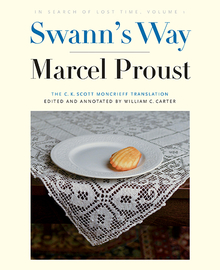Eugène Emmanuel Viollet-le-Duc (January 27, 1814 – September 17, 1879) was a French architect and theorist, famous for his "restorations" of medieval buildings. Born in Paris, he was as central a figure in the Gothic Revival in France as he was in the public discourse on "honesty" in architecture, which eventually transcended all revival styles, to inform the emerging spirit of Modernism.
Steeples at Martinville
 At a bend in the road I experienced, suddenly, that special pleasure, which bore no resemblance to any other, when I caught sight of the twin steeples of Martinville, on which the setting sun was playing, while the movement of the carriage and the windings of the road seemed to keep them continually changing their position; and then of a third steeple, that of Vieuxvicq, which, although separated from them by a hill and a valley, and rising from rather higher ground in the distance, appeared none the less to be standing by their side.
At a bend in the road I experienced, suddenly, that special pleasure, which bore no resemblance to any other, when I caught sight of the twin steeples of Martinville, on which the setting sun was playing, while the movement of the carriage and the windings of the road seemed to keep them continually changing their position; and then of a third steeple, that of Vieuxvicq, which, although separated from them by a hill and a valley, and rising from rather higher ground in the distance, appeared none the less to be standing by their side.In ascertaining and noting the shape of their spires, the changes of aspect, the sunny warmth of their surfaces, I felt that I was not penetrating to the full depth of my impression, that something more lay behind that mobility, that luminosity, something which they seemed at once to contain and to conceal.
More views at the Ecclesiastical Proust Archive
https://www.amisdeproust.fr/fr/
Water-lillies on the Vivonne
I haven't yet found any analysis of the unnamed fisherman in the straw hat. {{The Pont-Vieux led to a tow-path which, at this
point, would be overhung in summer by the bluish foliage of a hazel, under
which a fisherman in a straw hat seemed to have taken root. At Combray,
where I knew everyone, and could always detect the blacksmith or grocer’s
boy through his disguise of a beadle’s uniform or chorister’s surplice,
this fisherman was the only person whom I was never able to identify. He
must have known my family, for he used to raise his hat when we passed;
and then I would always be just on the point of asking his name, when some
one would make a sign to me to be quiet, or I would frighten the fish. }}
So. Proust wrote Impressions on Riding in an Automobile about
a car trip to Caen, where he saw the steeples shifting at Saint-Etienne
& Saint-Pierre. The pertinent part of the article later became the
boy Marcel's writing fragment, the one he jots down in the carriage.
See the page 437 preview in Carter's biography at this link. (Scroll down).
More analysis of the Martinville fragment in on page 38 of this essay (Ruskin, Proust, and the Art of Failure). (Use Ctrl F to find the word "Martinville").











